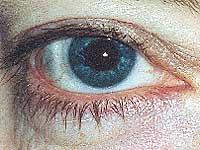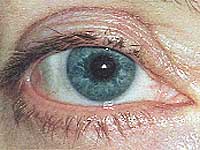Combined approach to lower lid blepharoplasty leaves orbital septum intact
Over the past 3 years, this procedure has been safely used with no cases of scleral show, ectropion, lower eyelid retraction or lateral canthal rounding.
The most common complications of total transcutaneous lower eyelid blepharoplasty (skin-muscle flap with removal of bulging fat pockets) are ectropion and lid retraction. Preoperative horizontal lid laxity or excessive surgical shortening of the skin can result in postop ectropion. Horizontal lid laxity can be identified preop by evaluating the appositional tension and elasticity of the lid. A lid retraction test (STASIOR, snap) and slit lamp evaluation of the tear film distribution are essential. Horizontal lid laxity is an indication for combining lateral canthal suspension with transcutaneous lower eyelid blepharoplasty.
Preoperative conditions
 ---Combined blepharoplasty preop.
---Combined blepharoplasty preop.
Preoperative conditions predisposing to lower eyelid retraction include shallow orbit, large eye, exophthalmos, malar hypoplasia and in repeat transcutaneous blepharoplasty. Surgical violation of the orbital septum (middle lamella) can result in vertical contraction of the septum and adjacent tissues resulting in lid retraction and scleral show. Postop ectropion and lid retraction can occur separately or together.
Careful preoperative evaluation should eliminate those patients at risk for these complications, or allow for surgical modifications to maximize lower eyelid stability. I routinely combine a lateral myopexy of the orbicularis muscle to the periosteum of the lateral orbital rim l mm superior to the lateral canthus in transcutaneous blepharoplasty. The orbiculopexy places the lateral canthal angle on a superolateral tilt that is aesthetically pleasing and reduces scleral show. It also places the orbital septum on vertical stretch, preventing septal contraction or the need for postop taping. I use a 5-0 polyglactin (5-0 Vicryl with a P-2 needle; Ethicon, Somerville, N.J.) suture.
The combination of transconjunctival lower eyelid blepharoplasty with periorbital laser resurfacing has become an alternative procedure to total transcutaneous blepharoplasty. Transconjunctival blepharoplasty removes bulging orbital and pre-capsulopalpebral fat, with improvement in mild to moderate loose skin by means of surgical re-draping. Laser resurfacing can smooth solar-induced rhytides, reduce or eliminate solar lentigo and keratoses, and tighten loose, folded skin. Intense, deep carbon dioxide (CO2) laser resurfacing inferior to the orbital rim can efface moderate orbital and jugal festoons.
Laser resurfacing has limitations and drawbacks. Deep resurfacing prolongs the degree and duration of postop erythema. Erbium laser resurfacing cannot tighten dermal collagen as dramatically as a CO2 laser. Dyspigmentation, at times permanent, occurs in a significant percentage of patients postoperatively. The tightening effect from laser resurfacing fades to a considerable degree from 6 months to 2 years postop. As in transcutaneous blepharoplasty, laser resurfacing can vertically shorten the skin of the lid, and in the predisposed patient may result in ectropion, scleral show or lid retraction. The recovery from CO2 laser lower eyelid blepharoplasty is quicker and less involved than laser resurfacing into the dermis of the lower eyelid.
Partial transcutaneous blepharoplasty
 ---Combined blepharoplasty 2 weeks postop.
---Combined blepharoplasty 2 weeks postop.
For patients with markedly excess lower eyelid skin or exaggerated pretarsal muscle folds with no bulging fat, a partial (skin-muscle flap only) transcutaneous blepharoplasty using a high-fluence continuous wave CO2 laser (UltraPulse; Coherent Medical, Santa Clara, Calif.) is a gratifying procedure. The laser facilitates a blood-free dissection of the skin and orbicularis muscle as a single smooth unit off the orbital septum with no orbicularis remaining on the septum. In patients with bulging fat pads and markedly excessive skin or pretarsal muscle bulge, a combined CO2 laser transconjunctival and partial (skin-muscle flap) transcutaneous blepharoplasty offer the advantage of not violating the orbital septum. The procedure is always combined with a lateral orbiculopexy.
The combined approach to lower eyelid blepharoplasty is performed under local anesthesia by a transconjunctival infra-orbital nerve block. One and one-half milliliters of a 50/50 mixture of 0.75% bupivacaine HCl (Marcaine; Abbott Laboratories) with 2% lidocaine (Xylocaine; AstraZeneca LP) with 1:100,000 epinephrine is given through a 0.5-inch 30-gauge needle. The transconjunctival portion is performed first. CO2 laser safe prep and drape and surgical instruments are routine. While gently retropulsing the globe with a CO2 laser prepared Jaeger metal lid plate (Byron; Tucson, Ariz.), the UltraPulse CO2 laser with a 0.2-mm focal tip on continuous wave at 8 watts is used to create an arcing incision through the conjunctiva 2 to 3 mm inferior to the inferior edge of the tarsal plate. The incision is deepened through lower eyelid retractors, exposing the fascial investments of the fat compartments. With combined defocused vascular photocoagulation and focused tissue vaporization, the fascia is incised and buttonholed, allowing for prolapse of bare fat. Vessels within the fat are photocoagulated, and the fat is sculpted flat to the conjunctival incision. Preservation of the fascial investment of the fat compartments may contribute to a more stable orbital septum. The entire procedure is performed posterior to the orbital septum.
Following the transconjunctival blepharoplasty, a CO2 laser safe, metal, corneal-scleral shield is placed (Cox II Ocular laser shield; Oculo-Plastik Inc., Montreal). The lower eyelid is placed on extreme superior stretch, and a 0.2-mm line of vaporization is performed 2 mm inferior to the lash line, from the punctum to the lateral canthus. It is connected to a l-cm tangential incision placed l mm lateral to the lateral commissure. With 2 to 3 mm of tarsal skin reflected, an incision is made through the orbicularis muscle. Focused laser dissection by vaporization creates a smooth, bloodless skin-muscle flap to the inferior edge of the preseptal area. The integrity of the orbital septum is visible by transillumination off the gray steel corneal-scleral shield. The bloodless dissection by vaporization and brief photocoagulation of vessels leave no blood, char or clots on the septum. Theoretically, this should prevent septal cicatrix formation with subsequent vertical contraction of the septum. A lateral orbiculopexy allows for tension-free skin closure, keeping the skin-orbicularis elevated during closure and healing. Skin closure is accomplished with four to six interrupted 6-0 polypropylene (Prolene; Ethicon) sutures.
Over the past 3 years, this procedure has been safely used in my practice. No cases of scleral show, ectropion, lower eyelid retraction or lateral canthal rounding have occurred.
For Your Information:References:
- David Bruce Welch, MD, is assistant professor of clinical ophthalmology at Northwestern University Medical School and attending ophthalmologist at Northwestern Memorial Hospital in Chicago. He can be reached at 60 E. Delaware, Ste. 1430, Chicago, IL 60611; (312) 255-0010; fax: (312) 337-5852. Dr. Welch has no direct financial interest in any of the products mentioned in this article, nor is he a paid consultant for any companies mentioned.
- Baker SS, Glaser DA. Peri-orbital and facial laser applications. Medical Video Productions, 1996. St. Louis.
- Seckel BR. Aesthetic Laser Surgery. Little Brown & Co. 142-148.
